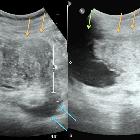Wunderlich-Syndrom









 nicht verwechseln mit: Herlyn-Werner-Wunderlich-Syndrom
nicht verwechseln mit: Herlyn-Werner-Wunderlich-SyndromWunderlich syndrome is a rare condition in which spontaneous non-traumatic renal hemorrhage occurs into the subcapsular and perirenal spaces.
Clinical presentation
Wunderlich syndrome is clinically characterized by Lenk's triad:
- acute flank pain
- flank mass
- hypovolemic shock
Mnemonic
- F: flank pain (acute)
- F: flank mass
- H: hypovolemic shock
Pathology
Etiology
- neoplastic
- neoplasms are the most common cause
- among benign neoplasms, angiomyolipoma is the commonest, while among malignancies, renal cell carcinoma is the commonest
- cases of hemorrhage from tuberous sclerosis and pregnancy-related angiomyolipomas have been reported
- non-neoplastic
- vascular causes: vasculitis (polyarteritis nodosa being the commonest cause), renal artery aneurysms, AV malformations and fistulas, renal vein thrombosis
- cystic renal diseases
- calculus disease
- nephritis
- coagulation disorders
Radiographic features
Hemorrhage in the perinephric space, often with a primary lesion seen within the kidney, e.g. angiomyolipoma, renal cell carcinoma.
Treatment and prognosis
If the hemorrhage is self-limiting and the patient is responsive to fluid resuscitation, the patient can be managed conservatively. Angiographic selective embolization may be pursued in haemodynamically stable patients. In haemodynamically unstable patients, emergent nephrectomy (partial or total) is often required .
History and etymology
It is named after the German physician Carl Reinhold August Wunderlich (1815-1877), who published the first case description in 1856, and who is most famously remembered for his pioneering work on clinical thermometry . The term Wunderlich syndrome was first recorded by Coenen in 1910 .
See also
Siehe auch:
- rupturierte Nierenzyste Trauma
- Polyarteriitis nodosa
- Nierenzellkarzinom
- Angiomyolipom der Niere
- Nierenblutung
- Nierenruptur
- cystic renal diseases
und weiter:

 Assoziationen und Differentialdiagnosen zu Wunderlich-Syndrom:
Assoziationen und Differentialdiagnosen zu Wunderlich-Syndrom:




